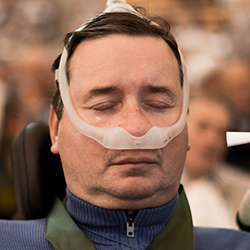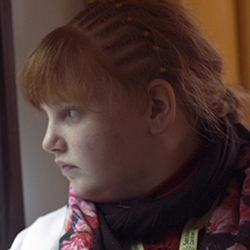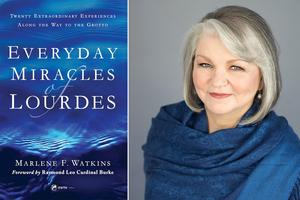An Ode to Our Lady’s Comforting Power in Lourdes
The author of the critically-acclaimed new documentary Lourdes discusses the genesis and ambition of this long-term project on the occasion of a screening at the Vatican.

VATICAN CITY –They are a dozen testimonies, whose lives are radically different but that converged by their common belief in the Virgin Mary’s intercession power. From the businessman in the terminal phase of an incurable disease to the transvestite prostitute struggling to find his true God-given identity; from the young boy who came with his dad to pray for the survival and recovery of his 2-year-old little brother to the teenaged girl victim of bullying, none of them was spared by the harshness of the earthly life. All of them suffer from deep wounds — and all of them manifest a burning desire to know God’s Mercy and love.
Lourdes, a 90-minute documentary film shot in 2017, traces their respective journeys in the midst of the hundreds of thousands of pilgrims from around the world who flock every year to the cave-grotto where, in 1858, the Virgin Mary appeared to St. Bernadette Soubirous.
Directed by French journalist Thierry Demaizière and film director Alban Teurlai, both renowned for the aestheticism of their documentaries and the deepness of their intimate portraits, the film released in 2019 has touched a very broad audience in the whole country and was nominated for the Césars in the category “Best Documentary Film.”
On the occasion of its upcoming Feb. 24 release in Italy, Lourdes was screened at the Vatican Film Library on the afternoon of Feb. 13, in the presence of the Prefect of the Dicastery for Communication, Paolo Ruffini, and French Ambassador to the Holy See, Elisabeth Beton Delègue. The screening was followed by a discussion with the film’s writer, Sixtine Léon-Dufour, and the Lourdes shrine’s former director of communications, François Vayne.
A journalist and “hospitaller” — a title given to those who take care of the sick in Lourdes — Léon-Dufour wrote the script and carried out the investigative work to find the pilgrims who were featured. In this interview with the Register, she discusses the long process through which the film was conceived and the particular spirit that she and the directors wanted to infuse in their work to better reveal the essence of this pilgrimage site.
How did the idea to do such a film take shape?
One day, after coming back from Lourdes with my husband where I went as a hospitaller, I talked about my experience with my friends Thierry Demaizière and Alban Teurlai and they said we should do something. I am a print journalist and I couldn’t have done it without them. Nothing had ever been done before on this topic. It is hard to believe, as this place is known worldwide. And strangely, the production house Mars Film immediately accepted the project, as well as co-producer Canal+, even though it is a very divisive topic. It is not easy to promote such a film in the cinema world in France. The whole project was approved in less than one month.
How did you develop the project? Did you already have witnesses in mind before starting writing the script?
From the beginning, I explained to the film directors that it was important for us to be at the heart of the reactor — that is, to be on the field with hospitallers and the sick. No one had done that before.
The investigation took eight months. I already knew Lourdes and what was very important to me from the beginning was to show the huge diversity of this place. It is not a place reserved to traditionalists or religious people. There is a place for anyone — whoever they are, wherever they come from, whatever their pain.
We spent a lot of time with Travellers, because I saw the way they did their annual pilgrimage and it is something very important. I also knew about a pilgrimage of prostitutes from Bois de Boulogne Park [near Paris], and I wanted to talk about them as well. I wanted to show humanity in its diversity.
The interviews were extremely long as many of the interviewees have suffered a lot and were reluctant to be filmed. I had to spend one or two nights a week during a whole winter at the Bois de Boulogne to shoot scenes with the team and Fr. Jean-Philippe Chauveau, the priest of Maison Magdalena [a Catholic association that gives assistance to homeless people and the prostitutes], to make myself accepted by the prostitutes, in order to earn their trust, and so that they get used to the camera. It wasn’t easy, but it was necessary.
The film directors repeated several times during interviews that this documentary was not about religion. So, what is it about?
It was indeed very important to emphasize that it is not a film about religion. It is about the human condition, humanity and transcendence. The question behind the film is that to understand what millions of people seek in this small grotto. It is not a film targeted to Catholics exclusively. It is addressed to everyone. We wanted to promote humanity in its entirety, in its most simple dimension. When people go to Lourdes they reveal themselves and are exposed in their poverty, in the proper sense and in a figurative sense.
It is a film about faith and transcendence, more than purely about religion. It is a film about human condition. This is how we could reach people far beyond the Catholic sphere.
Do you feel that this film has somehow troubled the directors – who define themselves an atheist and an agnostic – in their certainties?
First of all, I find it amazing that these two directors took on the project. Both of them are great portraitists — they are famous in France for their very intimate portrayals. They are really interested in human beings and their subject. They were the real architects of the project. They have an acute vision of the world and their images are absolutely beautiful. I actually think the fact that both of them are not religious is a true added value to the film, as it allowed them to have an adequate distance with regard to the subject. Each of us had a special role and tried to keep the right distance in carrying out our respective missions. The film aimed at touching a non-Catholic public also, and it did work in France.
But although they are not believers, the two directors were very respectful from the beginning and weren’t absolutely judgmental. Thierry Demaizière’s grandfather used to go to Lourdes so he wasn’t totally unfamiliar with it.
What infinitely touched their heart was to see that the smallest of this world — the sick or disabled people — are always in the forefront in Lourdes. They regain their dignity there. They often told me that it is a France that we don’t see and don’t know. So many people are in such deep misery and poverty.
Another thing that really struck them was to see the young people — as seen in the documentary — putting them at the service of the sick. These young people give one week of their free time to dedicate themselves to those in need. And they even pay to participate in the pilgrimage. They are like every other young person — they go out at night, drink alcohol and go to bed at 3 a.m., but they get up at 6 a.m. to go take care of the sick. Emma, a 23-year-old girl full of tattoos, whom we see in the film, is an atheist, but she goes to Lourdes every year to take care of the sick as it is something that gives her a structure for the rest of the year. The directors were very impressed.
One of the testimonies, Jean d’Artigues, a former CEO with Charcot’s disease, is said to have entered in palliative care and to be close to his death. How did he inspire you?

Ultimately, I was strongly touched by every testimony. The fact that all of them trusted us was a blessing. We really owe them, as we shook up their intimacy, both because of their pain and because of their physical handicap. Our main pitfall was the fact that they usually pray silently, from the depths of their hearts, and we needed them to pray out loud in order to better tell their stories. It was a sign of true confidence from them.
What struck you the most personally in following the path of these singular characters?

I am happy that they came to trust us and I am particularly pleased to see the positive impact that the film has had in their life afterward. They received a lot of messages of support. One of the characters, Céline, a young teenager who was bullied at school, had her life completely changed after the documentary was released. She had stopped going to school and she could go back to school afterward.
What is the specific message of universality that gathered all of these very different people in Lourdes?
These personal stories were meant to show the incredible diversity of Lourdes. Let’s say that it is a digest of humanity. We are at the heart of the human being, in his poverty, in his richness, his weaknesses and greatness… in his truth. Lourdes is a place of truth. No one ever pretends in Lourdes. And that is the beauty of it. Everyone is true to oneself. No one can cheat.
But still, what makes this place so unique and so universally overwhelming — even to atheists — is the presence of the Virgin Mary…
Of course. And people know it, even if it is only deep inside. We can see that in the film. When someone goes to Lourdes, he comes to our Mother in Heaven who gives us comfort. It is a place of deep consolation.
Do you know if the film will be released in the U.S. soon?
There is an ongoing project of distribution in the U.S., so it probably will. This film is definitely suited to an American public.
- Keywords:
- lourdes















